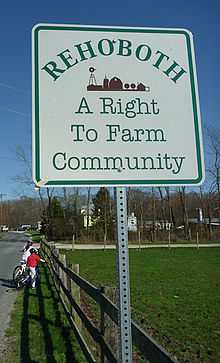Right-to-farm laws

Right to Farm laws in the United States deny nuisance lawsuits against farmers who use accepted and standard farming practices and who have been in prior operation, even if these practices harm or bother adjacent property owners or the general public. Agricultural nuisances may include noise, odors, visual clutter and dangerous structures. All fifty states have some form of Right to Farm law.
Many of these laws were passed after 1980 due to the reduction of available farmland, adversity from private and public nuisance actions which hinder the prospect of farming. Right to Farm laws are aimed to minimize the threat to normal farming practices due to nuisance litigation and prohibitive state and local government regulation. In contrast to typical farmland preservation policies which aim to preserve farmland itself, Right to Farm laws attempt to preserve the agricultural practices and enhance farm viability. [1]
Locally Right to Farm laws represent support for farming practices by a community and, often so more refined and clearer than state laws. Local laws typically define the extent of protection farmers actually receive from nuisance suits and inappropriate regulation. Often times government officials enact Right to Farm laws in order to achieve agricultural resource preservation, environmental resource protection, and municipal growth management. All three motivations are related to open space, the environment, and quality of life. Right to Farm laws tend to increase as more farmland is lost, as the stock of open space in a municipality decreases, the it becomes more congested, quality of life becomes more compromised, hence a deteriorated environment.[1]
History
Right to Farm laws were developed in the 1970s as a response to suburban encroachment on agricultural land. The concern was that as farmland was converted to suburban developments, the new residents would bring lawsuits against the pre-existing farms complaining about agricultural noise, dust, and other nuisances.[2] The legal costs to defend themselves would tend to push farmers out of business, and the trend toward urbanization would accelerate. Right to Farm laws were created as a way to protect small-scale farmers from these lawsuits and thereby preserve the open space which made the communities attractive in the first place. Massachusetts passed the first Right to Farm law in 1979.[3]
Today, every state has some form of a Right to Farm law, although the content of these laws can vary greatly.[4]
Controversy
Although initially Right to Farm laws were passed as a means to protect small-scale family farms, recently large factory farms have used these laws to protect controversial agribusiness practices. For example, there is concern that Right to Farm laws may be used as a shield to allow giant factory farms to pollute groundwater.[3]
References
- ↑ 1.0 1.1 Adesoji and Friedman, Adelaja and Keith (1 December 1999). ""Political Economy of Right-to-farm."". EconBiz. Journal of Agricultural and Applied Economics: 568.
- ↑ "RIGHT-TO-FARM LAWS: HISTORY & FUTURE" (PDF). Farm Foundation. Retrieved 19 March 2015.
- ↑ 3.0 3.1 Richardson, Jill. "ALEC Exposed: Protecting Factory Farms and Sewage Sludge?". PRWatch. The Center for Media and Democracy. Retrieved 19 March 2015.
- ↑ "Right to Farm Laws". Sourcewatch. The Center for Media and Democracy. Retrieved 19 March 2015.
 This article incorporates public domain material from the Congressional Research Service document "Report for Congress: Agriculture: A Glossary of Terms, Programs, and Laws, 2005 Edition" by Jasper Womach.
This article incorporates public domain material from the Congressional Research Service document "Report for Congress: Agriculture: A Glossary of Terms, Programs, and Laws, 2005 Edition" by Jasper Womach.